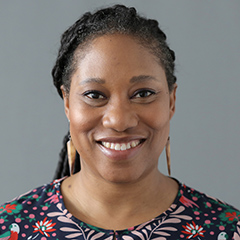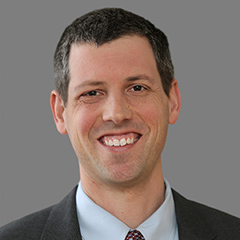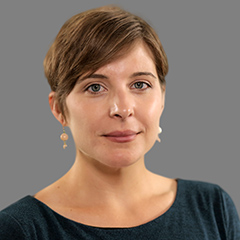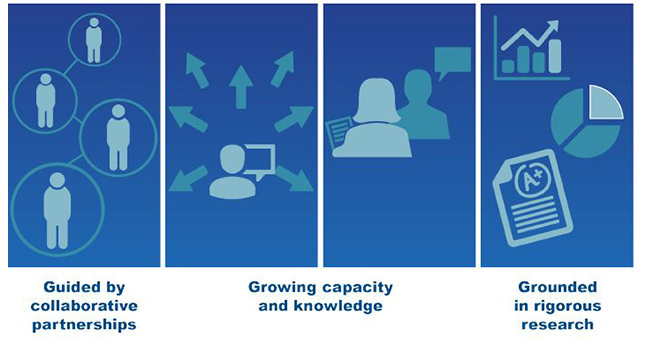This blog is based on a presentation conducted jointly by REL Central and REL Mid-Atlantic with district partners Dr. Brooks Rosenquist Montalvo (Denver Public Schools), as well as Ms. Michelle Gainer and Dr. Nyshawana Francis-Thompson (School District of Philadephia) for the National Network of Education Research-Practice Partnerships Annual Forum. We are grateful to be partnering with these talented and committed leaders.
Working in partnership to improve practice and promote equity
The work of the Regional Educational Laboratories (RELs) takes place within structured, collaborative partnerships with state, Tribal, and local education agencies, addressing high-priority challenges through applied research; training, coaching, and technical support; and dissemination of evidence. The Institute of Education Sciences (IES) has tasked the 10 RELs with working with partners to address issues related to educational equity. At REL Central and REL Mid-Atlantic, we’re diving deeply into this work, including through two new equity-focused research-practice partnerships in Denver Public Schools and the School District of Philadelphia (see sidebars).
Strengthening Student Pathways to Success in Math (Denver Public Schools, REL Central)
* Focused on improving math performance and opportunities systemwide, particularly for Black and Hispanic students.
Using Measurement and Evidence to Promote Racial Equity in Philadelphia (REL Mid-Atlantic)
* Focused on dismantling inequitable classroom practices throughout the district and empowering all students to succeed.
How can we know if we’re helping to improve educational equity?
As equity discussions occur across the RELs and within school systems across the nation, it’s important to avoid approaching “equity” as performative, or yet another buzzword. We need to deeply integrate equity into our beliefs, mindsets, and practices to ensure that all children in our schools are provided with the resources they need to succeed.
One way to approach this work is by looking for evidence that REL projects are disrupting the practices that lead to inequitable opportunities and outcomes. Knowing whether this work is helping to improve educational equity is extremely complex. Although it may sound simple enough to say that we need to collect and analyze the evidence, what we choose to measure is dependent on a host of variables. These include local contexts; educators’ current beliefs, behaviors, and practices; and students’ individual and collective needs. To help districts better understand what students are experiencing in schools, we can encourage them to deploy various data collection tools and analyze the results to learn from staff, students, and parents about their perceptions of the learning environment.
It’s important to remember that success is both technical and relational, and there is groundwork to put into place to ensure that equity becomes part of the fabric of the district. Some initial questions to consider are:
- What are students experiencing in schools? A 2018 report from TNTP, The Opportunity Myth, notes that four out of 10 classrooms with a majority of students of color never received a single grade-level assignment; rather, the work they were tasked with was below grade level. If gaps in achievement are a result, in part, of systematic differences in instructional rigor in classrooms that make up the student experience, it is imperative to make system changes. These could include concrete instructional and other practices to ensure equal access to high-quality learning environments for all students.
In Denver Public Schools, REL Central is collecting qualitative data in focus groups and using surveys to understand students’ experiences in math across grades to reveal barriers and supports to their success. This initiative will pay special attention to the experience of Black and Hispanic students. Similarly, in partnership with the School District of Philadelphia, REL Mid-Atlantic plans to develop survey items and possibly other data collection tools to learn from staff, students, and parents about their perceptions of the learning environment.
- Is there a focus on elevating marginalized voices? Are we asking students, parents, and the community what it means to be equitable and inclusive? Surveys and focus groups can reveal the extent of and nature of the work that needs to be done to ensure that it is inclusive and actively engages these groups.
- Are teachers and administrators encouraged to interrogate their mindsets and beliefs about students and how they intersect with tangible teaching practices, student learning, and organizational governance? Are teachers and leaders being held accountable for dismantling racist and inequitable mindsets and practices? Does teacher professional learning include an explicit, integrated focus on equity? Working with our partners, we will develop an understanding of the landscape and create professional development modules for educators that address these issues.
Making new practices “stick”
When we focus on shifting mindsets and learning environments and adopting concrete evidence-based instructional practices, we also need to acknowledge that lasting change takes time—time to influence implicit belief systems, teacher and school leader behavior, and instructional practice. Each REL cycle spans five years so partners have time to improve their systems, which requires targeting the REL work to outcomes that are achievable within that time frame. One way that RELs approach this work is to learn what has worked elsewhere. Do we have evidence or information on promising practices that will allow us to move the dial without reinventing the wheel? We might, for example, conduct a landscape analysis to locate tools that other districts have successfully used to develop equitable learning environments.
This partnership model also, importantly, focuses on work that is driven by our partners. We’re working closely with leadership in Philadelphia and Denver to deeply understand their priorities and potential solutions, identify indicators of success, and continually refine and measure implementation of the work. As we look beyond what we know now to our vision for what we will accomplish through this partnership work, we’re excited about the opportunities ahead, and look forward to keeping you updated.
Cross-posted from the IES website.




